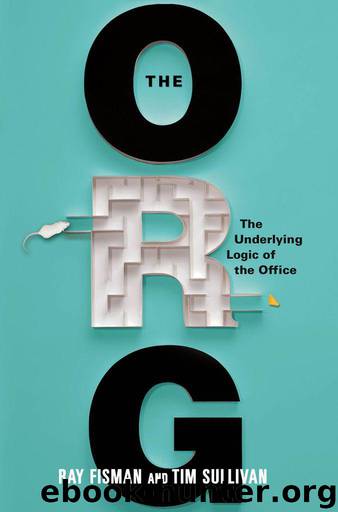The Org: The Underlying Logic of the Office by Ray Fisman & Tim Sullivan

Author:Ray Fisman & Tim Sullivan [Fisman, Ray]
Language: eng
Format: mobi, epub
ISBN: 9781455517534
Publisher: Grand Central Publishing
Published: 2013-01-07T14:00:00+00:00
The Dark Side of Management, Part II: Managers versus the Managed
Without managers, orgs would likely come to a grinding halt. Or at least, like the Indian textile factories, they might end up with heavy equipment blocking passageways and owners wearing inventory keys around their necks. Or as one popular manager of computer programmers who moonlights as an online management guru puts it: WHILE YOU WERE USELESSLY STARING AT THAT ONE BUG THIS MORNING I WAS KEEPING THIS ORGANIZATION MOVING PAL.17
When you examine how managers spend their days, however, it doesn’t feel as if they’re the engines that make orgs run. Take, for instance, one of the natural habitats of the manager: meetings. Meetings can feel like a grand waste of time, ill conceived, at best—and some of them certainly are. Paul Graham, a computer programmer and venture capitalist, points out that meetings, while part and parcel of the manager’s toolkit, cost the “maker”—that is, the worker who’s actually trying to produce something—valuable time. Graham writes, “There are two types of schedule, which I’ll call the manager’s schedule and the maker’s schedule. The manager’s schedule is for bosses. It’s embodied in the traditional appointment book, with each day cut into one-hour intervals. You can block off several hours for a single task if you need to, but by default you change what you’re doing every hour.” He goes on: “When you’re operating on the maker’s schedule, meetings are a disaster. A single meeting can blow a whole afternoon, by breaking it into two pieces, each too small to do anything hard in.”18
Like the Peter Principle, this message feels like a dose of blessed common sense in the world of organizational nonsense, focusing as it does on the fact that it is the average worker who actually gets stuff done. Without makers, this line of reasoning goes, there’d be no org at all. Fair enough—and what average worker wouldn’t want to hear that? But at least some of the apparent pointlessness of meetings reflects the inherent inefficiency in ferreting out “soft” information, the state of affairs that can’t be coded into a spreadsheet. Meetings’ written counterparts (memos and reports) similarly serve to collect information to feed the org, while distracting the maker from the “real” work that needs to get done.
Large organizations need to impose some degree of uniformity (part of the manager’s role) for the same reason that McDonald’s doesn’t allow franchisees to offer hand-carved roast beef sandwiches—quality control over the inputs of production, including information. Meetings and memos and reports, the essential tools of management, serve this function, even though they may resemble nothing but disruption to the work lives of those who feel they are the ones actually producing something.
From this confluence (organizational necessity and maker hostility) managers are at least twice damned. They’re watching over and coordinating the hard work the market couldn’t handle—hence all the soft information and meetings, which are critical but disagreeable aspects of organizational life. In pinning this unpleasantness on managers, we’re falling prey
Download
The Org: The Underlying Logic of the Office by Ray Fisman & Tim Sullivan.epub
This site does not store any files on its server. We only index and link to content provided by other sites. Please contact the content providers to delete copyright contents if any and email us, we'll remove relevant links or contents immediately.
Rewire Your Anxious Brain by Catherine M. Pittman(18303)
Talking to Strangers by Malcolm Gladwell(12875)
The Art of Thinking Clearly by Rolf Dobelli(9916)
Mindhunter: Inside the FBI's Elite Serial Crime Unit by John E. Douglas & Mark Olshaker(8702)
Becoming Supernatural by Dr. Joe Dispenza(7836)
Change Your Questions, Change Your Life by Marilee Adams(7377)
The Road Less Traveled by M. Scott Peck(7279)
Nudge - Improving Decisions about Health, Wealth, and Happiness by Thaler Sunstein(7244)
The Lost Art of Listening by Michael P. Nichols(7160)
Mastermind: How to Think Like Sherlock Holmes by Maria Konnikova(6937)
Enlightenment Now: The Case for Reason, Science, Humanism, and Progress by Steven Pinker(6875)
Win Bigly by Scott Adams(6828)
The Way of Zen by Alan W. Watts(6289)
Daring Greatly by Brene Brown(6227)
Big Magic: Creative Living Beyond Fear by Elizabeth Gilbert(5354)
Grit by Angela Duckworth(5301)
Men In Love by Nancy Friday(4964)
Ego Is the Enemy by Ryan Holiday(4958)
Altered Sensations by David Pantalony(4867)
